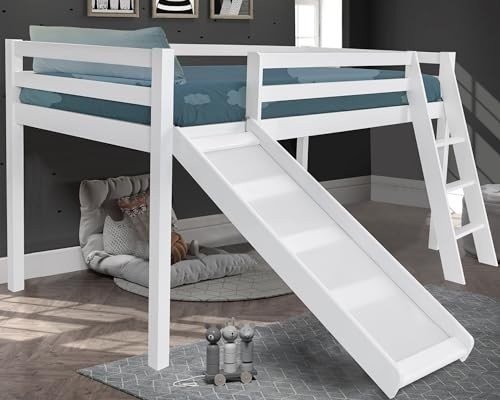5 Clarifications On Kids Bunk Bed
The Ultimate Guide to Kids Bunk Beds: Maximizing Space and Fun
With the increase of vertical living and smaller sized areas, the popularity of bunk beds has soared among families. Luis Arias use a useful sleeping option, specifically in shared rooms, but they also bring an element of fun into a child's life. This extensive guide looks into the features, advantages, and factors to consider of kids' bunk beds, making it easier for parents to choose the best bed for their youngsters.
Functions of Kids Bunk Beds
Bunk beds are flexible furniture pieces that serve more than a single purpose. Here are some essential functions to consider:
Feature
Description
Product
Bunk beds can be constructed from wood, metal, or a combination of both, offering differing levels of toughness and style alternatives.
Safety Features
The majority of bunk beds come equipped with guardrails, secure ladders, and capped assistances for security, particularly essential for children.
Design Variety
Options range from traditional designs to modern styles, guaranteeing a match for any room design.
Space-Efficiency
Bunk beds make use of vertical space, making them perfect for smaller sized rooms.
Convertible Options
Some designs can be transformed into 2 separate beds, supplying flexibility as kids grow.
Storage Solutions
Some bunk beds come with built-in storage drawers or racks, helping to keep the room organized.
Benefits of Kids Bunk Beds
Buying a bunk bed includes a number of advantages:
- Space Saving: Bunk beds take full advantage of floor space, enabling for more play location or storage solutions.
- Fun Factor: With a bunk bed, kids belong that cultivates creativity and friendship throughout slumber parties or playdates.
- Cost-efficient: Instead of acquiring 2 different beds, a bunk bed can accommodate two kids at the same time, saving money in the long run.
- Versatility: Many bunk beds can be disassembled or transformed into twin beds, making them a long-term investment as children's requirements alter.
- Social Interaction: Bunk beds motivate household bonding and friendships, providing an inviting space for kids to share stories and laughter.
Factors to consider When Choosing a Kids Bunk Bed
When picking the perfect bunk bed for a child, moms and dads need to consider numerous elements:
- Safety Standards: Ensure that the bunk bed adhere to safety policies and comes with vital security features.
- Age Appropriateness: Different designs cater to various age. For example, standard bunk beds may not appropriate for younger kids.
- Room Dimensions: Measure the bed room to ensure the bunk bed fits properly, permitting for space to move around comfortably.
- Weight Capacity: Consider the weight load of each bed and guarantee it accommodates the child's weight conveniently.
- Style Preferences: Letting kids get involved in the choice process can help them feel more fired up about their new bed.
Types of Kids Bunk Beds
Bunk beds can be found in various designs and setups to suit various needs:
Type
Description
Standard Bunk Bed
A timeless design with one bed stacked on top of another, typically utilizing a ladder to access the top bunk.
L-Shaped Bunk Bed
Features two bunk beds linked in an L-shape, often more roomy and ideal for kids sharing a space however needing a bit more space.
Triple Bunk Bed
Comprises three stacked beds, perfect for optimizing sleeping plans in very restricted areas.
Loft Bed
A raised bed with space underneath that can act as a backyard, research study corner, or additional storage.
Futon Bunk Bed
Integrates a bunk bed on leading with a futon or sofa beneath, making it great for sleepovers and making the most of room usage.
Convertible Bunk Bed
Can be separated into 2 private beds, using versatility as children's requirements alter.
Caring for Kids Bunk Beds
Preserving bunk beds is essential for ensuring longevity and security. Here are some easy care practices:
- Regular Inspections: Check the bed frequently for loose screws and tightened up bolts to guarantee stability.
- Cleanliness: Keep bedding clean and fresh, turning bed mattress for even wear.
- Guardrails: Ensure guardrails are safe and in location, particularly if kids tend to move around a lot in their sleep.
- Air Circulation: Ensure the bed has enough air flow, preventing wetness accumulation that can cause mold or mildew.
Frequently Asked Questions About Kids Bunk Beds
Q1: At what age can a kid securely use a bunk bed?
A1: Generally, children aged 6 and older are thought about safe to utilize the upper bunk due to the height and stability factors included.
Q2: Can I put a bunk bed near a window?
A2: It is suggested to prevent positioning a bunk bed near windows to lower the risk of falling or injuries.
Q3: Are bunk beds safe for younger kids?
A3: While some contemporary bunk beds come with security features accommodating younger children, it is usually suggested to wait till they are older, normally over 6 years.
Q4: What is the common weight limit for top bunks?
A4: Weight limitations vary by design however typically vary from 150 to 250 pounds. Always describe the producer's specifications.
Q5: How frequently should I inspect the bunk bed's security features?
A5: It is advisable to conduct a safety check every couple of months or whenever you observe any signs of wear.
Kids' bunk beds serve as a strategic option for households aiming to make the most of space while providing a fun and appealing sleeping environment for their kids. With a range of options available— from standard designs to loft beds— parents have the liberty to select something that meets their family's specific requirements. By considering essential aspects such as safety, space suitability, and their children's preferences, parents can make an informed option, ensuring that each child is excited about bedtime while taking advantage of an efficient space.
